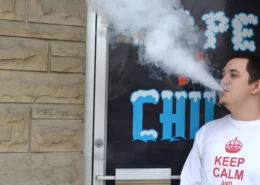Is Secondhand Vapor Harmful? Debunking the Concerns
E-cigarettes (especially the disposable vapes) have grown in popularity in the United States and Europe over the last decade, which makes many people concerned about the potential health hazards linked with vaping. While these devices have not been on the market long enough for us to completely understand their long-term consequences, we may estimate the relative hazards of vaping vs combustible cigarettes using the safety profiles of the chemicals involved. Surprisingly, our understanding of the potential dangers of secondhand vapor to bystanders may actually outweigh our understanding of the risks to vapers themselves. Scientists can evaluate the possible risk that inadvertent bystanders may encounter when exposed to secondhand vapor by evaluating workplace exposure regulations for inhaled chemicals and metals. Thus far, there is no substantial evidence that secondhand vaping poses a serious harm to the health of non-vapers.
Understanding Secondhand Vapor
When it comes to secondhand vapor, we are referring to the aerosol produced by e-cigarettes that is exhaled into the surrounding atmosphere. It’s important to understand that secondhand vapor is not the same as secondhand smoke. While secondhand smoke from combustible cigarettes contains harmful substances released through the process of combustion, secondhand vapor does not result from burning any material. Instead, e-cigarettes heat e-liquid using a small metal coil in an atomizer, transforming it into the vapor that we see. As a result, secondhand vapor does not contain carbon monoxide or tar, and the particles in the aerosol are in liquid form rather than solid.
Secondhand Vapor VS Secondhand Smoke
To understand the potential risks associated with secondhand vapor, it is crucial to compare it to the dangers of secondhand smoke. Smoke produced by burning any substance, including tobacco, contains volatile gases, carcinogenic solid particles, carbon monoxide, and a variety of harmful byproducts. Prolonged exposure to secondhand smoke can have severe health implications. In contrast, secondhand vapor from e-cigarettes contains significantly lower levels of toxicants. While there are trace amounts of chemicals and metals present in the vapor, the concentrations are minute compared to those found in smoke. This stark contrast in toxicant levels significantly diminishes the potential risks associated with secondhand vaping.
Contents of Secondhand Vapor
When individuals vape indoors, the visible secondhand vapor is solely a result of exhalation by the vapers in the room. Unlike the constant emission of smoke from a lit cigarette, e-cigarettes require the user to inhale to produce vapor. By the time the vapor is exhaled, it contains substantially fewer substances than were present in the inhaled vapor. This is because most of the vapor is absorbed by the user’s mouth, throat, and lungs during inhalation. As a result, there are only negligible amounts of toxicants left in the exhaled vapor, making it unlikely to pose a significant concern for secondhand vaping.
The main components of secondhand vapor, apart from the base ingredients of propylene glycol (PG) and glycerin (VG), are present in low levels. In fact, according to toxicologist Igor Burstyn from Drexel University, the exhaled vapor contains such minimal contamination that the risk to bystanders is unlikely to be of any real consequence. While it is true that some nicotine may settle on surfaces, referred to as “thirdhand nicotine,” the amount remaining is negligible. The majority of inhaled nicotine is retained by the user and does not contribute to the exhaled vapor.
Exploring the Air Quality Impact
Concerns about the impact of secondhand vapor on air quality are also worth addressing. Studies have shown that particles in vapor, which are in liquid form rather than solid like smoke particles, do not appear to have any significant effect on air quality. Research conducted by the University of California-San Diego analyzed the air quality in 193 low-income family homes and found that activities such as smoking tobacco or marijuana, cooking, and burning candles had measurable impacts on particle counts. However, the act of vaping, which occurred in 43 of the homes, did not have a discernible effect on indoor air quality.
Furthermore, even studies conducted in vape shops have indicated that levels of toxicants are below occupational exposure limits. The National Institute for Occupational Safety and Health (NIOSH), a CDC agency, conducted a study in a shop where 13 customers vaped throughout the day. The results showed that flavoring chemicals and formaldehyde in the air were all below the allowable exposure limits, and nicotine was practically absent from the samples. These findings suggest that the potential risks associated with secondhand vaping in controlled environments are minimal.
Is Secondhand Vapor Harmful?
In 2018, Public Health England updated its evidence review on e-cigarettes and once again emphasized that no identified health risks of passive vaping to bystanders have been identified to date. Igor Burstyn’s study on the potential dangers of secondhand vaping aimed to estimate the potential exposures from e-cigarette aerosols and compare them to occupational exposure standards. His conclusion was that bystanders’ exposures are likely to be orders of magnitude lower than those of vapers themselves, meaning the risk is significantly reduced. While this implies that secondhand vaping cannot be proven harmful to others, it is important to respect the concerns of family and friends.
Respecting the Concerns of Others
Even if the risks of secondhand vaping to bystanders are minimal, it is crucial to consider the concerns of those around us. Respecting the wishes of family members, friends, and visitors who may object to vaping is essential. As responsible vapers, it is important to be courteous and thoughtful, and if someone expresses discomfort, it is advisable to vape outside. Furthermore, people with respiratory problems like asthma may be more sensitive to irritants like propylene glycol and some flavorings included in e-cigarette vapor. As a result, it is preferable to avoid secondhand vapor in the company of people who are more prone to respiratory discomfort.
Particularly in regards to their environment and the air they breathe, children lack the capacity to make educated decisions. therefore, vapers should exercise good judgment and exercise more caution when it comes to vaping around children. While no studies have specifically measured the lung functions of babies or young children after regular exposure to secondhand vapor, it is prudent not to subject them to unnecessary risks. Vapers should prioritize the well-being and safety of children and refrain from exposing them to secondhand vapor.
Conclusion
In summary, based on the available evidence, there is no compelling reason to worry excessively about breathing secondhand vapor. The risks associated with secondhand vaping are significantly lower than those posed by secondhand smoke. The chemicals and metals present in secondhand vapor are present in minute quantities, making the dangers less significant. Furthermore, studies on air quality and exposure levels have consistently shown that the impact of secondhand vapor is negligible compared to other common household activities. However, it is essential to respect the concerns of family members, friends, and individuals with respiratory conditions, as their comfort and well-being should always be a priority. By maintaining a considerate approach, vapers can ensure a harmonious coexistence with those around them.
- Bestselling Vapes in UK After Disposable Ban: What to Stock 2025 - August 8, 2025
- Argentina Debates Stricter Vape Laws Amid Prohibition Failures - August 8, 2025
- Nigeria Advocacy Group Urged to Hike Tobacco & Vape Tax by 100% - August 8, 2025









